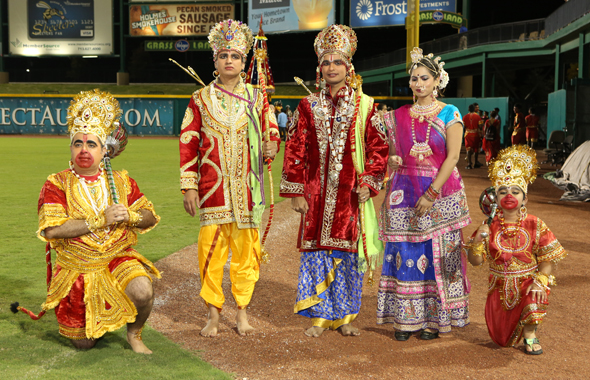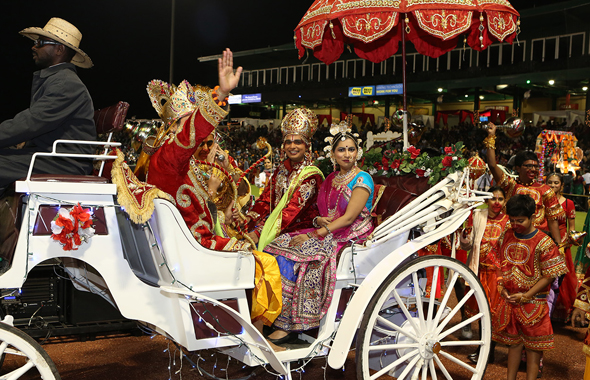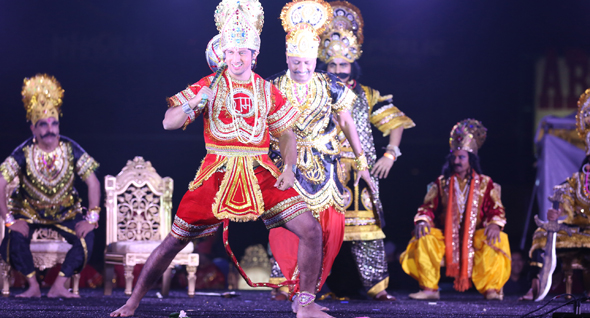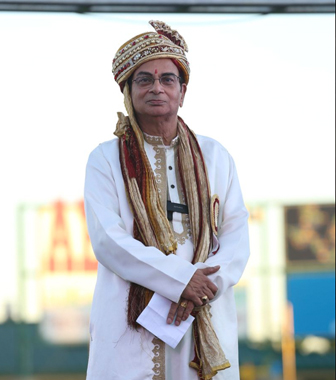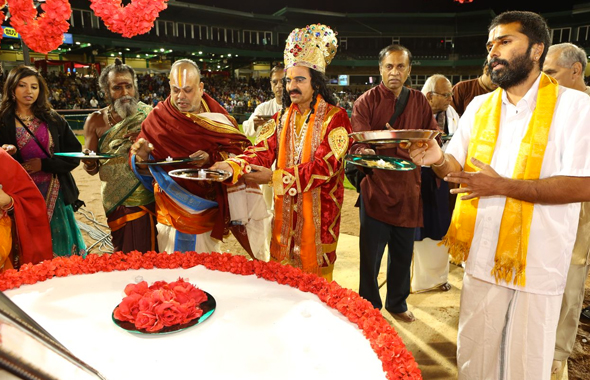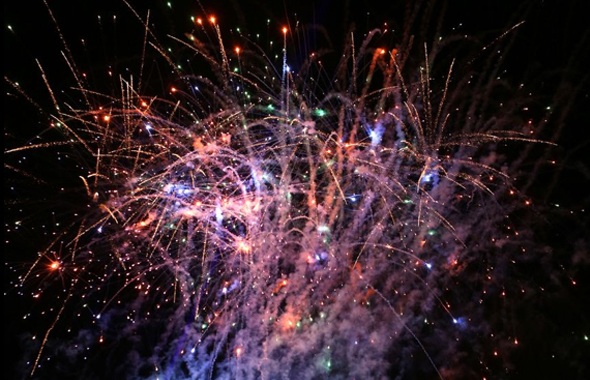Outdoor Ram Leela Packs Stadium with a Religious Revival of Culture, Pageantry, Food
Click here for Collage
By Jawahar Malhotra
SUGAR LAND: At the end of the Ram Leela, just as Ravana lay dead on the stage, a cheer went up through the thousands strong audience seated in the stadium; a cheer to mark their appreciation of the production of the epic story of the victory of Good over Evil which had never before been played out in Texas in the open air.
It was as much a cheer for those who are used to watching open air Ram Leelas staged all over North India, and especially the most popular and famous one in New Delhi. And it was especially a proud moment for Dr. Arun Verma and his wife Vinni whose original idea was to have just this very moment when they first worked on a Ram Leela production three years ago. ”This is all due to His guidance,” said Arun Verma, ever mindful that the success was coming from his faith in Lord Ram, who, he believed, made the weather clear up from the night before when it had rained heavily in parts of town.
This year’s Ram Leela production by the Sita Ram Foundation was rolled into a celebration of Dusserah – the culmination of the nine days of Navratri, marked on the tenth day of the tenth month, Ashwin, of the Hindu calender when Ram killed Ravana – and Diwali – which occurs three days later, on the thirteenth day, as it marks the return of Ram to his home after fourteen years of exile. Diwali and its five day festival begins this year on November 3.
Due to the rush of other groups wishing to celebrate it and on available venues, the SRF held their event this past Saturday, October 19 once again at Skeeters Stadium off Highway 6 in Sugar Land. The festivities followed a familiar setup, with a Diwali Mela featuring booths selling merchandise, food from several restaurants, games for kids and the activities of other community organizations. But by rolling three celebrations into one, the event opened earlier, at 4 pm and ended with a massive fireworks display around 10:30 that night.
“We had to condense the Ram Leela production into two hours”, explained a tired but delighted Arun Verma as he spoke by phone two days later. “We had to condense a four-hour stage show so that we could meet the deadline imposed by the fire department for the release of the fireworks”. This forced the last minute deletion of the final scene of the story, when Ram, Sita and Lakshman are reunited in the royal court of Ayodhya.
By embarking on this ambitious effort to bring a cultural extravaganza to the Houston area, the organizers added another element to this year’s show, a parade of religious and cultural floats and performers highlighting the multi-cultural diversity and inclusiveness inherent in daily life in India.
The parade started right after the Ram Leela ended and before the lighting of the effigies of Ravan, his son and his brother and the celebratory fireworks. It began with flags of the US, India and the crimson color flag of Lord Ram with motif of three sham vriksha leaves carried by a troop of Ismaili Boy Scouts. They were followed by the Govindji Gaudiya Matha group playing drums, dhol and cymbals; five floats depicting scenes from the Ram Leela; the Nishani group of female bhangra dancers; Kirtan dancers and celebrants from the Hare Krishna Temple; the Tassa group band; the U of H Garba group; Goddess Saraswati by the U of H group; an American band from HBU; the famous Wells Fargo stagecoach; Lord Kartikey by the Meenakshi temple; the Mysore Maharaja group by the Kanada Vrinda; Lord Jagannath’s Rath by the Orissa Cultural Center and the Ismaili Bagpipes Band coming at the rear.
The parade was a huge success and drew many people to the front to take pictures as the marchers and floats walked by the edge of the seats. The elaborate floats depicting religious figures – Durga Maata; Shiva and Parvati; Ravana, Kumbhakaran and Meghanath; Ram Parivar; and Lakshmi Narayan – were all made by the SRF and featured live people in costume and there was a rush to get photos of these.
“We are overjoyed that people enjoyed the parade so much”, said Verma, adding that the parade was supposed to go around the grounds twice but had to be cut back due to the firm deadline for the fireworks. He promised that the lessons learnt from this year would only make next year’s event even better. “We had 8,000 people there, according to the count kept at the entrance turnstiles”, explained Verma. “The parking lots were full and there are reports that 500 to 600 cars were sent back due to overflowing of the lots”. Many people who left early before the Ram Leela made room for others coming in.
This pained Verma and he is already considering a larger venue so that people would not be turned away from celebrating the glory of his deity, Lord Ram. As the event evolves, he has learnt how hard it is to manage 400 volunteers and adhere to a stringent deadline and format. This year’s Ram Leela was choreographed and directed by Ratna Kumar and her Anjali School of Performing Arts.
The stage show included preview events by other groups, introductions and speeches by prominent personalities and key supporters, a running narrative by Sangeeta Pasrija and the undeflatable Nik Nikam whose commentary was almost non-stop, and a raffle drawing (for which the parade was asked to pause) for two free tickets on Turkish Airlines by its General Manager. It was indeed heartening to see thousands of people standing in the aisles and at their seats for the aarti, LED diyas in their hands.
In the aisles behind the stands, there was elbow room only as the throngs made their way to the food court which featured quick, vegetarian snacks from one of the many food booths that catered samosas with chickpeas, chaat, freshly made hot dosas, sugar cane juice and masala tea among others. Muttered first time festival goer Kiran Bhimarao as he carried plates of food back to his family, “I love it, this is great. Reminds me of Delhi”, as he passed by people in Indian attire and many speaking in Hindi or their mother tongue.
It would have pleased Verma to hear this as the cultural extravaganza and reconnection with Indian roots was exactly what he had hoped the event would have recreated.

